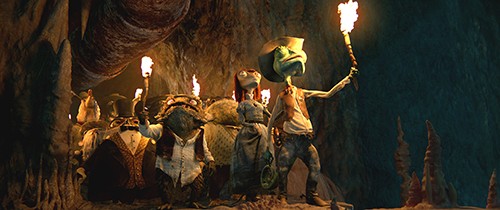In “”Rango,”” the newest genre-bending adventure from “”Pirates of the Caribbean”” director Gore Verbinski, a pampered pet lizard goes on a Wild West quest to bring water to the tortured town of Dirt. In the midst of an identity crisis, the lizard (Johnny Depp) names himself Rango, and adopts a new-sheriff-in-town persona. But does the wacky Western hit its target, or is it a muddled, heartless excuse for animated critters with guns? There’s some disputin’ in these parts.
THE GOOD:
Film and lit fans know they’re in for a trip by the opening scene. Aquarium bound, Rango riffs on a hero’s dependency on conflict. He is then ejected onto a highway in the Mojave. Irony: check. Amid his fall, he lands on the windshield of a convertible piloted by a long cigarette-filter in shades who is obviously Depp’s Hunter S. Thompson from “”Fear and Loathing in Las Vegas.”” Pop culture references: check. A few seconds later, the rent carcass of an unlucky armadillo explains to Rango that crossing the highway “”is a metaphor”” and he shouldn’t worry about it — yet. Literary humor: check. That’s three notches for “”Rango”” in the first five minutes, and it doesn’t stop there.
Enter the wacky “”Tom-and-Jerry”” chase sequences set to inappropriately upbeat mariachi scores (a la Verbinski’s other fractured Western, “”The Mexican””). Enter the supporting cast of deranged cowpoke critters, like pygmy owl mariachis who narrate the story in Greek chorus fashion, a love interest named Beans who is prone to wide-eyed, catatonic paralysis, and Rattlesnake Jake, a gunslinging serpent whose tail has been surgically swapped with a Gatling gun (awesome). Enter the spectral Spirit of The West, a familiar poncho-wearing badass voiced with true grit by “”Deadwood”” sheriff Timothy Olyphant (two shots of awesome).
There are slips, like an underdeveloped protagonist. But Rango is a chameleon — his genetic destiny is to subsume the appearance of other characters. He is, thanks to evolution, a natural-born archetype. Sure, the character’s real name is never revealed. But neither is Clint Eastwood’s in the legacy-setting “”Dollars”” trilogy.
The bastard child of “”Looney Tunes”” and “”The Wild Bunch,”” “”Rango”” is a film that knows what it’s doing. What it’s doing is creating an energetic, aesthetically beautiful though admittedly stereotypical Western about an animated lizard. If that’s not your brand of whisky, find another bar.
— Brandon Specktor
THE BAD:
In the midst of a character identity crisis occurring safely in the confines of aquarium walls, self-named hero Rango decides his movie script-in-progress lacks conflict. Cue the meta-fiction: suddenly the lizard is launched out of his habitat, coming to a sliding halt on the side of a desert highway. Though the meta-fiction is as purposeless as the movie’s central character, an identity crisis has never been more warranted: prior to his self-naming, Rango was never given an identity.
One of the central problems with the movie is its underdevelopment; the characters are cardboard cut-outs of what they could have been with proper fleshing out. But fleshing out is impossible when there are 38 christened characters; 38 unidentifiable, grotesque, mammalian and reptilian puppets that traipse across the desert, their only function being to keep the story trudging down its overly simple and solitary path toward an expected ending. But when the characters leave barely an imprint on your memory (let alone your soft-spot), what of the action? It’s as empty as Dirt’s water jug.
Sure, Rango’s serendipitous hero persona can be appreciated for its attempt at something different. “”Rango”” comes complete with the voice of Ned Beatty, aka “”Toy Story 3″” baddie, Lotso, as a malevolent mayor, but the main character’s aimlessness bleeds into the plotline and muddles up the action, causing even the most purposeful hunt for the stolen agua reserve to seem muddied and unsure, lacking heart.
The art is just as spectacular as the number of artists involved, and the voices lack no talent, but what happened to the story? It’s not so bad, but it’s not so good either.
— Kim Kotel









